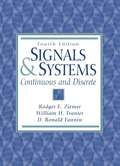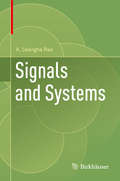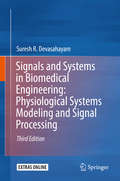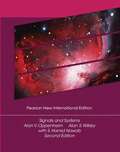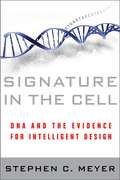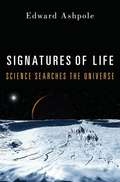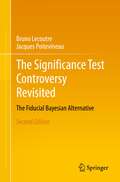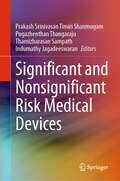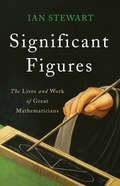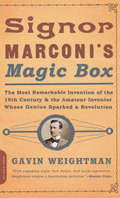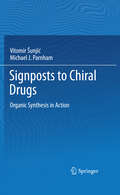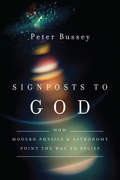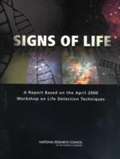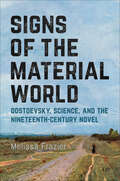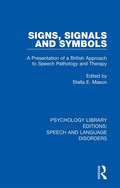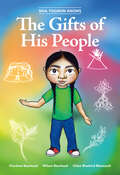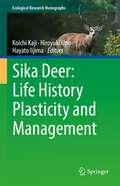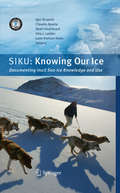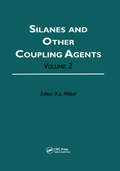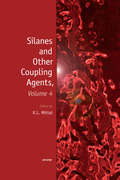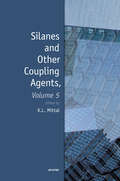- Table View
- List View
Signals and Systems: Continuous and Discrete (4th Edition)
by D. Ronald Fannin Rodger E. Ziemer William H. TranterA market leader in previous editions, this book continues to offer a complete survey of continuous and discrete linear systems. It utilizes a systems approach to solving practical engineering problems, rather than using the framework of traditional circuit theory. Numerous examples from circuit theory appear throughout, however, to illustrate the various systems techniques introduced. The Fourth Edition has been thoroughly updated to effectively integrate the use of computers and to accurately reflect the latest theoretical advances.
Signals and Systems
by K. Deergha RaoThis textbook covers the fundamental theories of signals and systems analysis, while incorporating recent developments from integrated circuits technology into its examples. Starting with basic definitions in signal theory, the text explains the properties of continuous-time and discrete-time systems and their representation by differential equations and state space. From those tools, explanations for the processes of Fourier analysis, the Laplace transform, and the z-Transform provide new ways of experimenting with different kinds of time systems. The text also covers the separate classes of analog filters and their uses in signal processing applications. Intended for undergraduate electrical engineering students, chapter sections include exercise for review and practice for the systems concepts of each chapter. Along with exercises, the text includes MATLAB-based examples to allow readers to experiment with signals and systems code on their own. An online repository of the MATLAB code from this textbook can be found at github.com/springer-math/signals-and-systems.
Signals and Systems Analysis In Biomedical Engineering (Biomedical Engineering)
by Robert B. NorthropThe first edition of this text, based on the author's 30 years of teaching and research on neurosensory systems, helped biomedical engineering students and professionals strengthen their skills in the common network of applied mathematics that ties together the diverse disciplines that comprise this field. Updated and revised to include new materia
Signals and Systems in Biomedical Engineering: Signal Processing And Physiological Systems Modeling (Topics In Biomedical Engineering Ser.)
by Suresh R. DevasahayamPhysiology is a set of processes that maintain homeostasis, and physiological measurement is a means of observing these processes. Systems theory and signal processing offer formal tools for the study of processes and measured quantities. This book shows that systems modeling can be used to develop simulations of physiological systems, which use formal relations between the underlying processes and the observed measurements. The inverse of such relations suggest signal processing tools that can be applied to interpret experimental data. Both signal processing and systems modeling are invaluable in the study of human physiology. Discussing signal processing techniques ranging from filtering and spectrum analysis to wavelet analysis, the book uses graphs and analogies to supplement the mathematics and make the book more accessible to physiologists and more interesting to engineers. Physiological systems modeling helps in both gaining insight and generating methods of analysis. This book shows how numerical computation with graphical display, haptics and multimedia can be used to simulate physiological systems. In this third edition the simulations are more closely related to clinical examination and experimental physiology than in previous editions. Detailed models of nerve and muscle at the cellular and systemic levels, and simplified models of cardiovascular blood flow provide examples for the mathematical methods and computer simulations. Several of the models are sufficiently sophisticated to be of value in understanding real world issues like neuromuscular disease. The book features expanded problem sets and a link to extra downloadable material containing simulation programs that are solutions to the theory developed in the text.
Signals And Systems: Pearson New International Edition
by Alan V. Oppenheim Alan S. WillskyFor undergraduate-level courses in Signals and Systems. This comprehensive exploration of signals and systems develops continuous-time and discrete-time concepts/methods in parallel -- highlighting the similarities and differences -- and features introductory treatments of the applications of these basic methods in such areas as filtering, communication, sampling, discrete-time processing of continuous-time signals, and feedback. Relatively self-contained, the text assumes no prior experience with system analysis, convolution, Fourier analysis, or Laplace and z-transforms.
Signature in the Cell
by Stephen C. MeyerOne hundred fifty years ago, Charles Darwin revolutionized biology, but did he refute intelligent design (ID)? In Signature in the Cell, Stephen Meyer argues that he did not. Much confusion surrounds the theory of intelligent design. Frequently misrepresented by the media, politicians, and local school boards, intelligent design can be defended on purely scientific grounds in accordance with the same rigorous methods that apply to every proposed origin-of-life theory. Signature in the Cell is the first book to make a comprehensive case for intelligent design based upon DNA. Meyer embarks on an odyssey of discovery as he investigates current evolutionary theories and the evidence that ultimately led him to affirm intelligent design. Clearly defining what ID is and is not, Meyer shows that the argument for intelligent design is not based on ignorance or "giving up on science," but instead upon our growing scientific knowledge of the information stored in the cell. A leading proponent of intelligent design in the scientific community, Meyer presents a compelling case that will generate heated debate, command attention, and find new adherents from leading scientists around the world.
Signatures of Life
by Edward AshpoleInformative and fascinating, this book delves into the topic of extraterrestrial life in a thought-provoking yet scientifically responsible way. Are we alone in the universe, or is life a universal phenomenon? For fifty years, astronomers in SETI (Search for Extraterrestrial Intelligence) have scanned the universe for intelligent signals, but with no success. In this intriguing book, Edward Ashpole explains the probable reasons for this and discusses other avenues of investigation more in line with the nature of science and technology. The author examines the problems inherent in scanning the universe for radio or optical signals from an alien intelligence. These include the difficulty of trying to communicate with another species possessing a completely unknown form of technology and the vast distances that alien communications would have to travel to reach us. This leads the author to other ways of finding evidence for extraterrestrial life, given that advanced civilizations would probably use artificial intelligence for interstellar travel. Our scientists now know how to detect the presence of life on a planet by observing its spectral lines, so more advanced alien researchers would have had ample time (about two billion years) to investigate these "signatures of life" coming from Earth. Hence, the author argues, alien space probes could exist within our own solar system; there might be evidence on the erosion-free Moon or on another moon or planet. In fact, a few scientists have scanned NASA's best photography, looking for evidence of such "alien archaeology." In a final chapter, the author urges an open-minded attitude on the part of scientists to all credible sources of information, along with the use of the scientific method to test various hypotheses and weed out the fantasy factor, which so often interferes with serious attempts to find hard evidence of extraterrestrial intelligence.
The Significance Test Controversy Revisited: The Fiducial Bayesian Alternative
by Bruno Lecoutre Jacques PoitevineauThis book explains the misuses and abuses of Null Hypothesis Significance Tests, which are reconsidered in light of Jeffreys’ Bayesian concept of the role of statistical inference, in experimental investigations. Minimizing the technical aspects, the studies focuses mainly on methodological contributions. The first part of the book gives an overview of the major approaches to statistical testing and an enlightening discussion of the philosophies of Fisher, Neyman-Pearson and Jeffrey. The conceptual and methodological implications of current practices of reporting effect sizes and confidence intervals are also examined and challenged. This sheds new light on the "significance testing controversy" and provides an appropriate Bayesian framework for a comprehensive approach to the analysis and interpretation of experimental data. The second part of the book provides concrete Bayesian routine procedures that bypass common misuses of significance testing and are readily applicable in a wide range of real applications. This approach addresses the need for objective reporting of experimental data, that is acceptable to the scientific community. This is emphasized by the name fiducial (from the Latin fiducia = confidence). The fiducial Bayesian procedures provide the reader with a real opportunity to think sensibly about problems of statistical inference. This book prepares students and researchers to critically read statistical analyses reported in the literature and equips them with an appropriate alternative to the use of significance testing.
Significant and Nonsignificant Risk Medical Devices
by Prakash Srinivasan Timiri Shanmugam Pugazhenthan Thangaraju Thamizharasan Sampath Indumathy JagadeeswaranThis comprehensive resource explains the FDA's classification of devices and provides expert guidance on differentiating between significant risk and non-significant risk medical device studies. The book is divided into two parts: Significant Risk Medical Devices and Non-Significant Risk Medical Devices. Each chapter includes a general introduction and overview of the device, along with guidance on its working principles, beneficial and toxicological effects, and potential risks to the health and safety of a patient/subject. The coverage also includes reports of prior investigations on the basics of risk determination and the nature of potential harm associated with using individual devices.Significant and Non-Significant Risk Medical Devices is designed to assist practicing engineers, academic researchers, and clinical investigators in navigating the complex regulatory environment associated with medical device research and development.
Significant Figures: The Lives And Work Of Great Mathematicians
by Ian StewartA celebrated mathematician traces the history of math through the lives and work of twenty-five pioneering mathematiciansIn Significant Figures, acclaimed mathematician Ian Stewart introduces the visionaries of mathematics throughout history. Delving into the lives of twenty-five great mathematicians, Stewart examines the roles they played in creating, inventing, and discovering the mathematics we use today. Through these short biographies, we get acquainted with the history of mathematics from Archimedes to Benoit Mandelbrot, and learn about those too often left out of the cannon, such as Muhammad ibn Musa al-Khwarizmi (c. 780-850), the creator of algebra, and Augusta Ada King (1815-1852), Countess of Lovelace, the world's first computer programmer.Tracing the evolution of mathematics over the course of two millennia, Significant Figures will educate and delight aspiring mathematicians and experts alike.
Signor Marconi's Magic Box: The Most Remarkable Invention Of The 19th Century & The Amateur Inventor Whose Genius Sparked A Revo
by Gavin WeightmanThe world at the turn of the twentieth century was in the throes of "Marconi-mania"-brought on by an incredible invention that no one could quite explain, and by a dapper and eccentric figure (who would one day win the newly minted Nobel Prize) at the center of it all. At a time when the telephone, telegraph, and electricity made the whole world wonder just what science would think of next, the startling answer had come in 1896 in the form of two mysterious wooden boxes containing a device Marconi had rigged up to transmit messages "through the ether. " It was the birth of the radio, and no scientist in Europe or America, not even Marconi himself, could at first explain how it worked. . . it just did. Here is a rich portrait of the man and his era-a captivating tale of British blowhards, American con artists, and Marconi himself-a character par excellence, who eventually winds up a virtual prisoner of his worldwide fame and fortune.
Signposts to Chiral Drugs
by Michael Parnham Vitomir SunjicHighlighting 15 selected chiral structures, which represent candidate or marketed drugs, and their chemical syntheses, the authors acquaint the reader with the fascinating achievements of synthetic and medicinal chemistry. The book starts with an introduction treating the discovery and development of a new drug entity. Each of the 15 subsequent chapters presents one of the target structures and begins with a description of its biological profile as well as any known molecular mechanisms of action, underlining the importance of its structural and stereochemical features. This section is followed by detailed discussions of synthetic approaches to the chiral target structure, highlighting creative ideas, the scaling-up of laboratory methods and their replacement by efficient modern technologies for large-scale production. Nearly 60 synthetic reactions, most of them stereoselective, catalytic or biocatalytic, as well as chiral separating methodologies are included in the book. Vitomir Sunjic and Michael J. Parnham provide an invaluable source of information for scientists in academia and the pharmaceutical industry who are actively engaged in the interdisciplinary development of new drugs, as well as for advanced students in chemistry and related fields.
Signposts to God: How Modern Physics and Astronomy Point the Way to Belief
by Peter Bussey"The heavens declare the glory of God" (Ps 19:1). Can we still sing the words of the Psalmist in an age where scientists talk about an expanding cosmos, the Higgs boson, and the multiverse? In Signposts to God particle physicist Peter Bussey introduces readers to the mysteries of modern physics and astronomy. Written in clear, accessible prose, Bussey provides a primer on topics such as the laws of nature, quantum physics, fine-tuning, and current cosmological models. He shows that despite the remarkable achievements of science, the latest research in these fields does not lead to simple physicalism in which physical processes are able to explain everything that exists. Bussey argues that, far from ruling out a divine Creator, modern physics and astronomy present us with compelling signposts to God. The more we know about the cosmos and our presence in it, the more plausible belief in God becomes. We can be intellectually satisfied in both science and the Christian faith. Written by someone who has worked for years in scientific research, Signposts to God is a timely and winsome response to a cultural stalemate.
Signs of Life: A Report Based on the April 2000 Workshop on Life Detection Techniques
by Committee on the Origins Evolution Of LifeA Report Based on the April 2000 Workshop on Life Detection Techniques
Signs of Life: The Language and Meanings of DNA
by Robert PollackThe genetic age is upon us, yet most people have only a limited understanding of the wondrous chemical that encodes the formula for all living things. As DNA's secrets are revealed, they must be rescued from the obscuring language of science, and now Signs of Life does just that. Borrowing from the humanities, Robert Pollack offers an entirely fresh perspective: DNA, he argues, should be seen as a great work of natural literature, a three-billion-year-old, continuously evolving text. An award-winning scientist and teacher, Pollack displays both a sophisticated understanding of biology and a remarkable gift for metaphor. In elegant prose, he shows precisely how DNA provides the instruction book for life. He takes us deep inside a living cell--a teeming walled city--and explains how the genetic script at its heart governs all its operations. He opens the book containing the human genome and lucidly reveals the process by which biologists and physicians have begun to read its words and sentences. But the frontier of genetics now extends into troubling territory. Pollack identifies several areas of concern: the ambitious but flawed Human Genome Project, the widespread access to individual genetic data, the temptation to manipulate genetic codes to make them "better." Given our still-crude ability to interpret these living texts, our eagerness to rewrite them is alarming. The power to change the human genome brings with it enormous responsibilities, and Pollack offers persuasive evidence that if we fail to achieve a fuller understanding of the multiple meanings of DNA, we risk disaster. Signs of Life is both a brilliant illumination of a biological text and a provocative meditation on our awesome new ability to alter it. With the grace of a born writer and teacher, Robert Pollack has written a book that will change the way people think about science, genetics, and the future of our species.
Signs of the Material World: Dostoevsky, Science, and the Nineteenth-Century Novel
by Melissa FrazierSigns of the Material World traces the literary effects of nineteenth-century materialism that includes the mind and body within a multifaceted “living life.” The book examines a range of scientists, from Auguste Comte and the “vulgar” materialists to Charles Darwin, James Clerk Maxwell, George Henry Lewes, Charles Sanders Peirce, and the Russian Nikolai Strakhov.The book sets Fyodor Dostoevsky in complex opposition to his fellow writers, Lev Tolstoy and Nikolai Chernyshevsky, while also exploring the formal connections that he shares with contemporaries across Europe and the United States, including Wilkie Collins, Charles Dickens, George Eliot, Nathaniel Hawthorne, and Friedrich Schiller. Melissa Frazier argues that Dostoevsky’s art serves as his science, both in his reliance on plot and in his recourse to an often-extravagant figurative language.This combined literary and scientific practice reflects Dostoevsky’s transnational and interdisciplinary reading; it also transforms our own. In George Eliot’s words, Dostoevsky “changes the lights for us.” Once drawn into his orbit, Eliot herself no longer looks quite the same. Finally, Signs of the Material World argues that Eliot and Dostoevsky’s particular strain of nineteenth-century materialism lends itself to an ambivalent political stance, as they both confront the certainties of social utopianism with a deliberate embrace of ambiguity.
Signs, Signals and Symbols: A Presentation of a British Approach to Speech Pathology and Therapy (Psychology Library Editions: Speech and Language Disorders)
by Stella E. MasonOriginally published in 1963, this title was an attempt to provide a new basis for the discipline of Speech Therapy. This was the first work to be published in England relating speech pathology to the wider study of human communication. It also contains results of original research into the problems of Dyslalia and Stammering. Several chapters are devoted to accounts of diagnostic measures and aids.
Siha Tooskin Knows the Gifts of His People (Siha Tooskin Knows)
by Charlene Bearhead Wilson BearheadTransportation, housing, agriculture, communications…there are so many modern conveniences. But are they really modern? Where did they really come from? Paul Wahasaypa—Siha Tooskin—will learn about their origins and more on his walk home from school with Ade (his father). There&’s so much to learn about the earliest forms of technology, travel, medicine, and food from right here on Turtle Island. Come along with Paul and Ade to hear all about the gifts of his people. The Siha Tooskin Knows series uses vivid narratives and dazzling illustrations in contemporary settings to share stories about an 11-year-old Nakota boy.
Siha Tooskin Knows the Gifts of His People (Siha Tooskin Knows)
by Charlene Bearhead Wilson BearheadTransportation, housing, agriculture, communications…there are so many modern conveniences. But are they really modern? Where did they really come from? Paul Wahasaypa—Siha Tooskin—will learn about their origins and more on his walk home from school with Ade (his father). There&’s so much to learn about the earliest forms of technology, travel, medicine, and food from right here on Turtle Island. Come along with Paul and Ade to hear all about the gifts of his people. The Siha Tooskin Knows series uses vivid narratives and dazzling illustrations in contemporary settings to share stories about an 11-year-old Nakota boy.
Sika Deer: Life History Plasticity and Management (Ecological Research Monographs)
by Koichi Kaji Hiroyuki Uno Hayato IijimaThis book provides complete and up-to-date information on sika deer biology and its management, focusing on their life history with an integrated approach of population dynamics, morphology, genetics, and evolution. The expanding distribution of sika and its increase in population in Japan and other countries are causing damage to agriculture and forestry, impacting ecosystems and affecting other species. We are facing conflicting deer issues regarding the conservation of resource values and pest control of sika deer. This contributed volume compiles new findings focusing on the ecological plasticity of the sika deer. It aims to clarify the ecological characteristics of the deer by integrating studies of different approaches and provides a perspective for their management. The book consists of six parts. Part I introduces the ecological and management background behind the history of sika deer. The following four parts discuss movement ecology (Part II), impact on vegetation and bottom-up effect on sika deer (Part III), impact on ecosystem and its resilience (Part IV), and comparison of life-history characteristics between sika deer and other ungulate species (Part V). The last part (Part VI) covers the science-based management of sika deer. Contributed by recognized experts and young researchers of sika deer, this book appeals to researchers and professionals in wildlife biology and wildlife management, evolution, population dynamics, morphology, genetics, and reproductive physiology.
SIKU: Knowing Our Ice
by Claudio Aporta Gita J. Laidler Igor Krupnik Lene Kielsen Holm Shari GearheardBy exploring indigenous people's knowledge and use of sea ice, the SIKU project has demonstrated the power of multiple perspectives and introduced a new field of interdisciplinary research, the study of social (socio-cultural) aspects of the natural world, or what we call the social life of sea ice. It incorporates local terminologies and classifications, place names, personal stories, teachings, safety rules, historic narratives, and explanations of the empirical and spiritual connections that people create with the natural world. In opening the social life of sea ice and the value of indigenous perspectives we make a novel contribution to IPY, to science, and to the public
SILAC: Methods and Protocols (Methods in Molecular Biology #2603)
by Jose L. Luque-GarciaThis detailed volume explores the most recent methodologies and applications of stable isotope labeling by amino acids in cell culture (SILAC). With the development of new technologies in the field of mass spectrometry and bioinformatics, SILAC-based methods have become the first tool of choice in quantitative proteomics either on its own or in combination with other more recently developed approaches, which is elucidated in the chapters of this book. Written for the highly successful Methods in Molecular Biology series, chapters include introductions to their respective topics, lists of the necessary materials and reagents, step-by-step and readily reproducible laboratory protocols, and tips on troubleshooting and avoiding known pitfalls. Authoritative and practical, SILAC: Methods and Protocols serves as an ideal guide for researchers working in the area of functional proteomics and other aspects of protein science.
Silanes and Other Coupling Agents, Volume 2
by K. L MittalThis book embodies the proceedings of the Second International Symposium on Silanes and other Adhesion Promoters held in Newark, New Jersey, October 21--23, 1998. Silanes are the most popular and widely used coupling agents (or adhesion promoters) to promote adhesion between dissimilar materials in a variety of situations, e.g. coating technology, adhesive bonding, reinforced composites, etc. Since the first symposium on this topic in 1991, there had been a tremendous R&D activity in developing new and more effective adhesion promoters and in understanding and optimising the performance of available coupling agents. The technical program for the symposium contained 36 papers and reflected both overviews and original research contributors and the presenters hailed from academia, industry and other research laboratories. Many different aspects of coupling agents were discussed, and both fundamental and applied aspects were accorded due coverage. In addition to formal presentations, there were brisk and lively discussions throughout the symposium, and this event provided an opportunity for cross-pollination of ideas in the broad arena of adhesion promoters. This present volume contains 18 papers by experts from academia, industry and other research laboratories. All manuscripts were subjected to rigorous peer review and were suitably revised before inclusion in this volume. The book is divided into two parts as follows: Part 1. Silane Coupling Agents; and Part 2: Non-silane Coupling Agents/Adhesion Promotors. The topics covered include: silane adhesion prompters for hydrosilylation cure systems; sterically hindered silanes; study of silanes hydrolysis; adsorption of silanes on different substrates; interaction of water with silane films studied by neutron reflection; characterization of glass fiber sizings; silanes as dispersion promoters; corrosion protection of metals by silanes; surface 'Intelligraft' as a new class of adhesion promoters; hydroxymethylated resorcinol, sol-gels, and -diketone functionalised polymers as adhesion promoters; and plasma deposition of silanes.
Silanes and Other Coupling Agents, Volume 4
by Kash L. MittalThis book chronicles the proceedings of the Fifth International Symposium held on this topic in Toronto. A total of 26 papers covering many ramifications of silanes and other coupling agents are included in this book. The topics covered include: various ways to deposit silanes; silane adsorption; investigation of interfacial interactions between si
Silanes and Other Coupling Agents, Volume 5
by Kash L. MittalThe topic of silanes and other coupling agents/adhesion promoters is of tremendous contemporary interest because of their application in many and varied technologically important areas ranging from coatings to reinforced composites to dentistry to biomedical (e.g., for bonding nucleotides to the so-called a gene chipsa ). In addition to their tra
